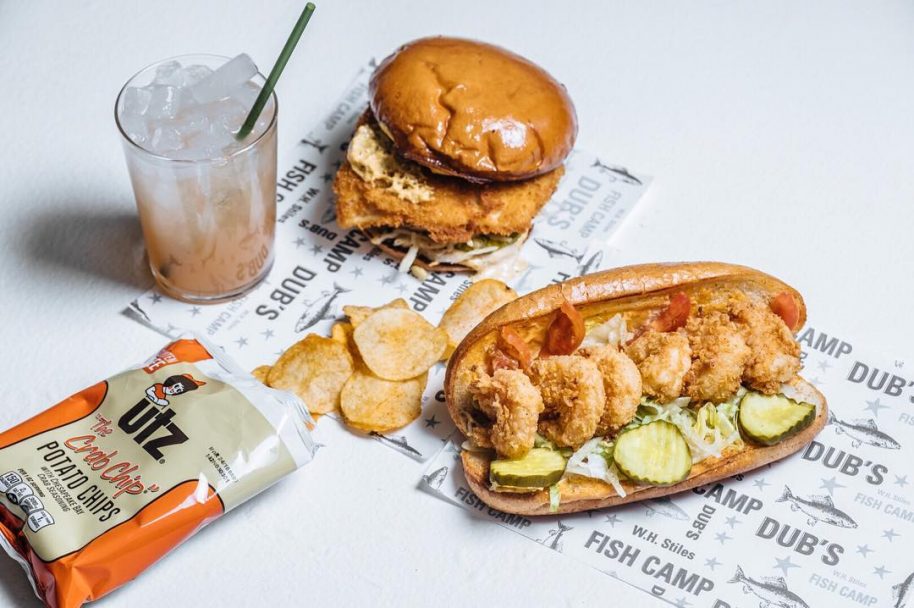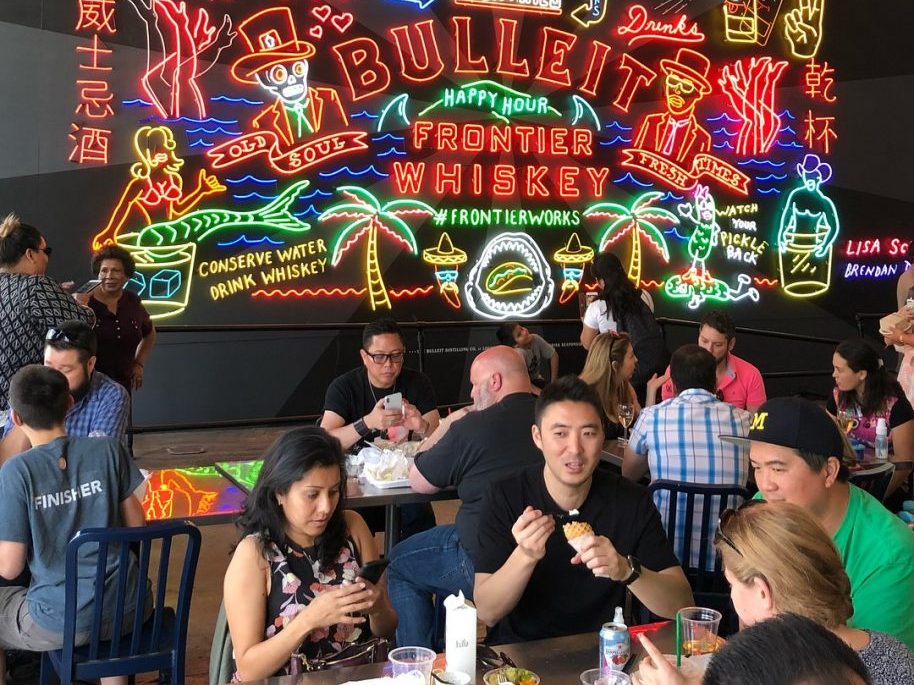Grand Central Market in Los Angeles. Photo: P. Eoche, Getty Images.
Food halls are revolutionizing the way Americans eat.
The trend, which appeared in Europe and Asia long before it made its way to the United States, combines the best elements of farmers markets, street food, and food courts under one roof. According to a 2018 report by commercial real estate brokers Cushman & Wakefield, “Food halls are not a fad. Food halls are the sharing economy for restaurants.” That same report predicts that there will 180 food halls operating in the U.S. by the end of this year. New York, California, Texas, and Florida lead the way with the highest number of food halls, but it won’t be long before most states can claim at least one of these unique eating environments.
Whereas people of all ages used to go to the mall to shop as a form of socializing, much of that activity has been replaced by online retail. Now people go out to dine, and it’s no longer just about grabbing a quick bite. “It’s an alternative experience for consumers. It’s a different vibe, a different experience,” says Adam Daneshgar, the current owner of Grand Central Market in Los Angeles and principal of Langdon Street Capital.
We took a look at the appeal of food halls and what’s cookin’ in them around the country. Food lovers, start your appetites.
Choice + Community = A Winning Combination
Food halls are not just upscale food courts. In fact, the only similarity between food courts and food halls is the density of venues under one roof. Other than that, they’re vastly different operations. Whereas food courts are known for chain fast food, food halls focus on local flavors and culture culinary niches. Variety is the big draw. Eaters can choose from a wide array of food at affordable prices in a fast-casual atmosphere. Food hall fare is often fresh, farm-to-table, organic, and/or gourmet. For couples, family, and groups, the food hall set-up also eliminates debates about what kind of cuisine to eat; everyone can get what they want and still share a meal at the same table. Food halls also allow drinkers to wander around an enclosed space, often peppered with retail stalls, while they enjoy their cocktails, wine, or beer.

Food halls can act as incubators for new food concepts, allowing owners to test out their menu and its sustainability without breaking the bank. Overhead is shared, so risk is lower than opening a traditional brick-and-mortar restaurant or even starting a food truck. Janitorial, security, and common area utilities and maintenance are all taken care of by the landlord. Because that infrastructure is already in place, a food vendor can move right in and start serving quickly. “You get to focus on your business, your restaurant, and getting the best food out to your customers,” says Daneshgar.
For celebrity chefs, food halls are an opportunity to share their fare at a lower price than a traditional restaurant.
Finally, food halls revive abandoned spaces. Atlanta’s Ponce City Market and Minneapolis’ Midtown Global Market are both housed in former Sears, Roebuck & Co. buildings. Food hall traffic also “feeds” nearby retail stores and shops, so it’s a win-win for business owners of all kinds.
Welcome to the Smörgåsbord
So where are these food halls and what makes them worth a trip?
“Eat, drink, repeat” is the motto at The Pennsy, an 8,000 square-foot space of high-end, chef-driven eats in New York City. Situated next to Madison Square Garden and atop Penn Station in New York City, it’s been open since 2016. Hit up The Cinnamon Snail for sweet vegan treats like peanut butter pop-tarts, get your beef on with an Angus steak sandwich at Pat LaFrieda, or go healthy with a big bowl of greens at The Little Beet. Another big attraction at The Pennsy? The open-air beer garden, of course.

Gotham West Market, open since 2013 in New York City, is 10,000 square feet of delicious comfort food options. Carb-heavy favorites like sweet and savory waffles from Waffle de Lys, meatball pizza from Corner Slice, a buttermilk-battered chicken sandwich at Eat Genuine, and inventive ice cream flavors including Snap Marshmallow Pop and The Munchies from Ample Hills Creamery (Zagat’s #1 rated ice cream shop in NYC) will surely hit the spot.
Central Food Hall at Ponce City Market opened its 30,000 square-foot space in Atlanta in 2015. Here, you can wash down a mushroom, Swiss, and gator chip burger with a milkshake at H&F Burger; try South African jerky and savory pies at Biltong Bar; indulge in fresh oysters at The Mercury; or sip and suck on a Guinness n’ Chocolate Sea Salt popsicle at King of Pops.
Grand Central Market in downtown Los Angeles is one of the country’s most enduring food-centric destinations, originally opened in 1917 and currently occupying 30,000 square feet. You can start your day here with a two-fisted breakfast sandwich at Eggslut, sample grilled shrimp and octopus tacos at La Tostaderia, nibble on a Salvadorian pupusa or fried plaintains at Sarita’s Pupuseria, or slurp on some vegan ramen at Ramen Hood. Stop at Clark Street Bread, Belcampo Meat Co., or Valeria’s Groceries on your way out for provisions for your next homemade meal. With fluorescent signs marking each vendor, bar-style seating, and views of your meal being made, Grand Central Market is a feast for the senses.

Revival Food Hall in Chicago boasts 15 vendors in 24,000 square feet of eatery space, making it the largest food hall in the Loop. Stop in for The Fat Shallot’s mind-blowing Truffle BLT (bacon, arugula, tomato, avocado and truffle aioli on challah). Check out the brand new TriBecca’s Cubano for its namesake sandwich that packs mouthwatering roasted pork, cured ham, Swiss cheese, chipotle mayo, pickles, and mustard butter in an olive oil panino (order it with a side of sweet potato fries and a dessert of griddled rum cake donuts to make a meal). Hot Chocolate will satisfy your sweet tooth with its array of cookies in varieties like the TCHO Chocolate and Sea Salt or the Hot Fudge and Smoked Sugar Thumbprint.
Elevate Food Hall in downtown Minneapolis is a multi-use space that functions as a place to eat as well as a lounge, outdoor event space, and conference center. Aimed at professionals looking for a lunch spot, it’s tucked away on the fourth floor of the 100 Washington Square building but offers panoramic views of the city and a pool table. This food hall combines local vendors with a celebrity chef concept, offering tempting menu items like the French Toast-Which, Bacon Tater Bowl, Buffalo Cauliflower from celebrity chef Jeff Mauro’s Pork & Mindy’s concept alongside a salad bar from Roots & Seeds and Japanese rice bowls from One Two Three Sushi.
A Trend That’s Here to Stay
Food halls aren’t just a passing phase in the American eater’s evolution. Cushman & Wakefield’s report cites stats that suggest food halls are the millennials’ preferred form of dining out. Considering that 44 percent of millennials spend their food dollars on eating out, 40 percent of millennials will order something different every time they visit the same restaurant, and 55 percent prefer communal tables when dining out, it would seem food halls are tailor made for young generations of foodies.

“There will be a tipping point eventually but that point is far off,” the report states. “To use the classic real estate baseball game analogy, Manhattan may be in the seventh inning, a few other markets like Denver or Miami may be in the fifth, but most of the nation’s markets have barely finished singing the national anthem.”
Until the fat lady sings, the food halls that will thrive and endure, according to the report, will be the ones that “embrace quality, authenticity and community.”




